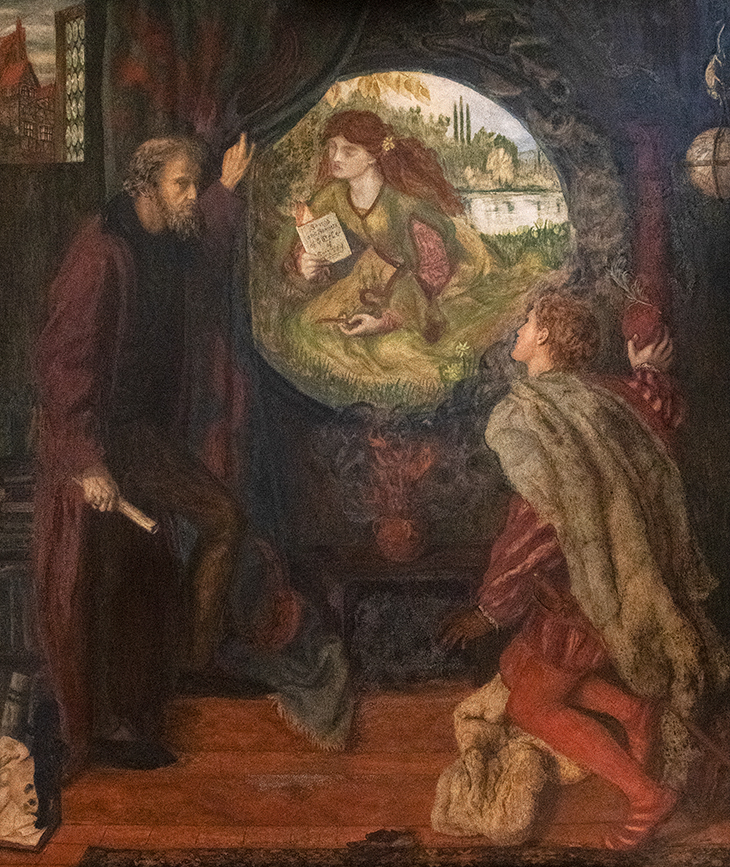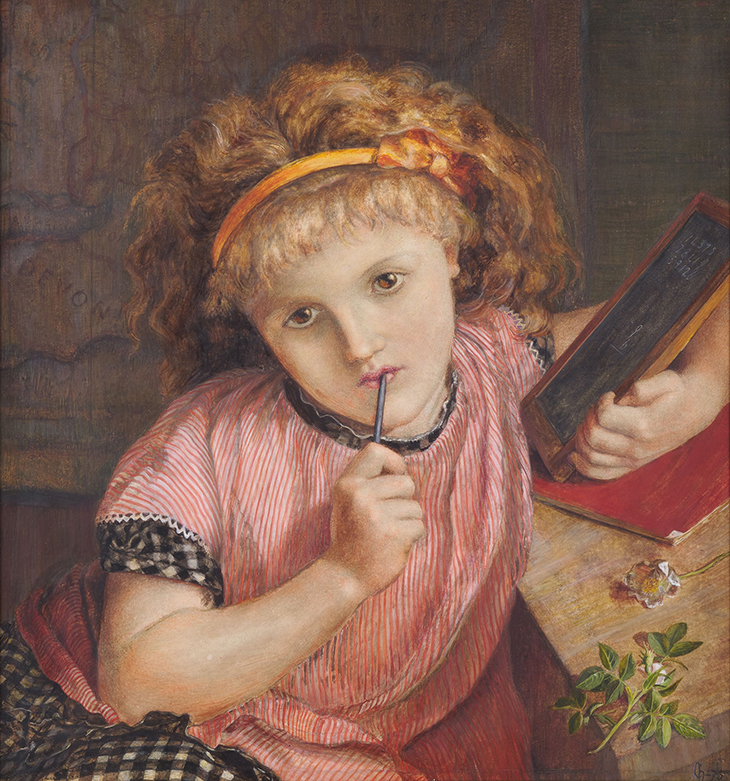Two significant artists were missing from the recent ‘Pre-Raphaelite Sisters’ exhibition at the National Portrait Gallery in London (October 2019–January 2020). Their omission, due to an over-crowded cast list, was especially regretted by me and my fellow curator Alison Smith, because these two were literal rather than metaphorical sisters. Half-sisters, to be precise. Lucy and Catherine were daughters of Ford Madox Brown, a father figure to the Pre-Raphaelite Brotherhood who declined to join the band because of its juvenile title, but who provided support to the group and its aims. Both women produced accomplished and original works, which, having mostly remained in private hands since they were created, are virtually unknown. So an exhibition dedicated to Lucy and Catherine Madox Brown at the Watts Gallery in Surrey, curated by Ruth Brimacombe, offers a rare opportunity to meet these ‘lost Pre-Raphaelites’.
Lucy’s mother, Elizabeth, was Brown’s first wife, who died in 1846 when Lucy was three years old. In her teens she was educated by the mother and sister of Dante Gabriel Rossetti, and at the age of 30 she married his brother William. Catherine was born in 1850 to Brown’s model Emma Hill, whom he married in 1853. Mother and blonde baby Cathy feature in Ford Madox Brown’s plein-air painting The Pretty Baa Lambs (1852; Ashmolean). She had two brothers: Oliver and Arthur, who died aged nine months in 1857.
The Pretty Baa Lambs (1852), Ford Madox Brown. The Ashmolean Museum, University of Oxford

Both sisters modelled for their father, and were drawn into studio practice in the mid 1860s, alongside Oliver and another of Brown’s students, Marie Spartali. Soon all began their exhibiting careers. Lucy’s early work The Duet (1870) presented an 18th-century scene with elements of chinoiserie, an unusual choice of period for a Pre-Raphaelite; otherwise her preference was for subjects drawn from drama and history – notably Romeo at the Tomb, Ferdinand and Miranda Playing Chess and The Magic Mirror, from a legend about the Earl of Surrey by Thomas Nashe. All marked by distinctive imagination and, especially, fine colour effects, these works extend the Pre-Raphaelite canon in respect of both style and content.
The Fair Geraldine or The Magic Mirror (1871), Lucy Madox Brown. Private collection

Loaned to this show from Wightwick Manor, that great repository of Pre-Raphaelite works, Romeo at the Tomb was praised by the Times on its exhibition debut as ‘a drawing of rare sentiment’, executed with ‘uncommon power’. The Magic Mirror is an especially welcome exhibit, as it has never been seen and will repay discussion in respect of its unusual source, its rich colour scheme and its relation to work by Brown, Rossetti, Spartali and Burne-Jones.
One fine pastel portrait by Lucy is that of the philosophic poet Mathilde Blind (1872), who was close to the Brown family, and who bequeathed the portrait together with a scholarship endowment to Newnham College, Cambridge, in the early days of women’s higher education.
Mathilde Blind (1872), Lucy Madox Brown. Newnham College, University of Cambridge

Cathy’s two companion portraits of her parents deserve wider circulation. Although only that of her father is included in the exhibition, it is accompanied by two hitherto unseen drawings from 1887. She perhaps had less interest in history and more natural artistic talent than Lucy, endowing portraits and contemporary genre scenes with visual interest and harmonies. The child puzzling over the sum 9+6 on her slate in A Deep Problem (1875; Birmingham Museum and Art Gallery) combines charm, observation and empathy. At The Opera (1869) is a stunning take on the usually formulaic half-length with decorative accessories. Was Marie Spartali the model?
A Deep Problem: 9 and 6 make – (1875), Catherine Madox Brown. Birmingham Museums Trust

It is interesting that while both artists’ works contain certain Brownian echoes, they also possess greater suavity than their father’s often gnarled and awkward compositions. Colour sense and rhythms are sophisticated. Qualities prized by Victorian critics and audiences were technical capacity and moderate conceptual originality – neither ‘same old’ nor startlingly new. With such skill and pictorial intelligence, the Madox Brown sisters could have become significant artists, drawing on their Pre-Raphaelite inheritance to take it beyond the imitative variations of the age.
But after Lucy married William Rossetti, she diverted her considerable ambition from art to educating their four (surviving) children and hosting a literary salon. Then the foul air of London wrecked her lungs and she died in Italy in her early fifties. Cathy married the music critic Franz Hueffer and simply relinquished professional practice, although portraits of her husband (1875) and daughter-in-law Elsie Martindale (1895) indicate an ongoing impulse. Widowed young in 1889, Cathy lived with her father until his death in 1893. Her wayward elder son, later to reinvent himself as the novelist and editor Ford Madox Ford, caused her considerable anxiety, which was partly offset by her daughter Juliet, who studied music, married the Russian exile David Soskice and became what the novelist Rebecca West described as a ‘pioneer translator’ of Russian literature.
The Madox Brown sisters’ relatively modest output, together with its relatively high quality, will make this first exhibition of their work a great chance to assess and indeed establish their place within the Pre-Raphaelite movement. How do their pictures compare? What adjustments to the critical history do they provoke?
‘Uncommon Power: Lucy and Catherine Madox Brown’ is at the Watts Gallery, Guildford, from 28 September–20 February 2022.


